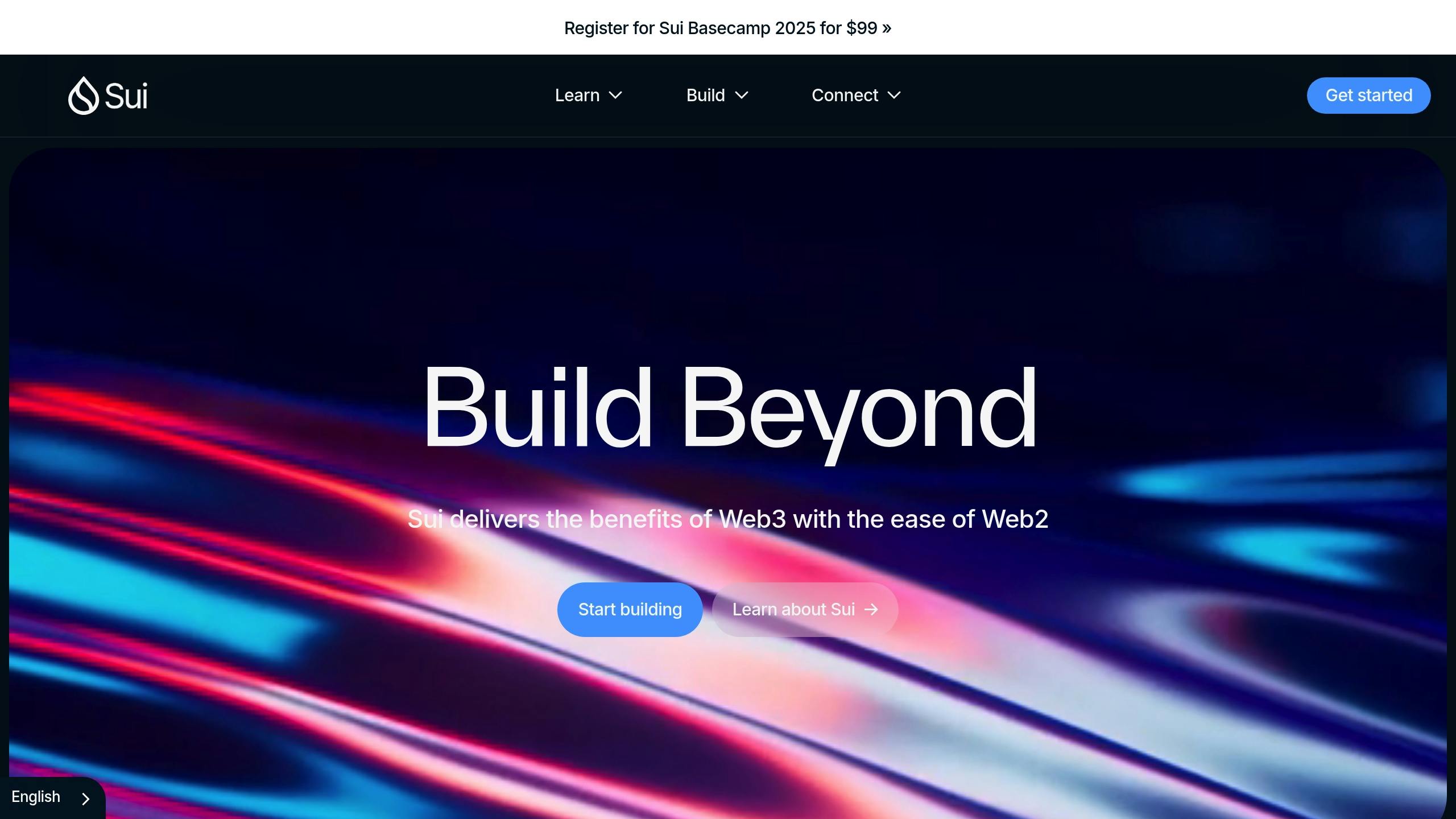SUI is a high-performance Layer 1 blockchain designed for scalability and efficiency. Its object-based data model enables parallel transaction processing, making it faster and more flexible than traditional blockchains like Ethereum. With features like the Narwhal & Bullshark consensus system, instant finality, and horizontal scaling, SUI is built to handle complex applications in DeFi, gaming, and NFTs.
Key Highlights:
- Object-Based Data Structure: Treats assets as individual objects, allowing for real-time updates (e.g., dynamic NFTs, gaming items).
- Consensus System: Combines Narwhal for mempool management and Bullshark for transaction ordering, achieving 297k TPS in stress tests.
- Scalability: Horizontal scaling improves performance as more validators join.
- Ecosystem Tools: Includes DeepBook (DEX), Turbos Finance, and Scallop Lend for DeFi, plus resources like Sui SDK and Wallet Kit for developers.
- SUI Token: Powers governance, staking, transaction fees, and storage, with 860M tokens in circulation as of October 2023.
Quick Comparison:
| Feature | SUI | Solana | Aptos |
|---|---|---|---|
| Consensus | Narwhal & Bullshark | PoS with PoH | BFT PoS |
| Transaction Speed | 120,000+ TPS | 65,000 TPS | 160,000 TPS |
| Finality Time | Sub-second | 400ms | Sub-second |
| Data Model | Object-centric | Account-based | Resource-oriented |
SUI’s architecture and tools make it a strong choice for developers and enterprises looking for speed, low costs, and scalability in blockchain applications.
Sui Network: A Beginners Guide To SUI Crypto

Core Features and Design
SUI brings forward three major advancements aimed at solving persistent issues in the blockchain world. These features, built on SUI’s technical framework, drive its impressive performance.
Object-Based Data Structure
At the heart of SUI’s design is its object-focused approach to handling data. Unlike traditional account-based models, SUI treats all assets and data as separate, independently managed digital objects [1]. This allows for precise control and tracking of digital assets.
For developers, this means they can directly interact with individual assets, such as game items. This structure is particularly useful for:
- Dynamic NFTs: Assets can change over time while keeping a clear record of ownership.
- Gaming Items: Enables real-time updates and modifications to in-game assets.
Narwhal & Bullshark System
SUI’s consensus mechanism integrates Narwhal’s mempool management with Bullshark’s ordering system [1][7]. In 2023 stress tests, this combination achieved an impressive 297k TPS.
| Feature | Capability | Benefit |
|---|---|---|
| Parallel Processing | Handles multiple transactions simultaneously | Increases throughput |
| DAG Structure | Processes concurrent blocks | Reduces latency |
| Instant Finality | Confirms transactions in under a second [1] | Provides a smoother user experience |
Network Scaling
SUI takes a unique approach to scaling by enabling horizontal growth [1]. Unlike traditional blockchains, which often face performance bottlenecks as they expand, SUI’s performance improves proportionally with the addition of new validators.
This capability is especially valuable for applications like:
- High-frequency trading platforms that demand stable and consistent performance.
These advancements lay the groundwork for the ecosystem features discussed in the next section.
SUI Platform Components
SUI’s ecosystem is designed to take full advantage of its object-based architecture and efficient consensus system, making it a strong choice for scalable applications.
DeFi Applications
Thanks to SUI’s parallel processing, DeFi protocols can achieve sub-second finality even under heavy demand. Its ability to handle high throughput with minimal delays makes it ideal for decentralized finance.
DeepBook, SUI’s built-in decentralized exchange, is a key part of its DeFi framework. With a central limit order book design, it ensures smooth asset trading at low fees. This efficiency helped SUI hit $36 million in total value locked (TVL) just four days after its launch [10].
Turbos Finance uses concentrated liquidity pools and rebasing mechanics to boost capital efficiency [1].
Scallop Lend has attracted $15 million in TVL within seven months, offering support for major stablecoins.
These tools lay the groundwork for SUI’s expansion into NFTs and gaming.
NFT and Gaming Tools
SUI’s object-based model brings unique benefits to NFTs and gaming assets. It supports dynamic asset updates while keeping ownership records transparent and secure.
For example, Netmarble‘s Grand Cross: Metaworld uses SUI’s architecture to manage mutable in-game assets with traceable histories [1]. The platform’s low transaction costs enable:
- Dynamic management of in-game items
- Large-scale interactions between players
Development Resources
The SUI platform is built on the Move programming language, which focuses on asset-based programming to ensure secure and efficient smart contracts.
Key development tools include:
- Sui SDK: Simplifies smart contract deployment
- Wallet Kit: Helps onboard users smoothly
- Interactive Tutorials: Speeds up prototyping for developers
These resources make it easier for developers to build and innovate within the SUI ecosystem.
sbb-itb-dd9e24a
Token System and Control
The SUI token plays a key role in the network, handling both economic and governance tasks. It supports the blockchain’s structure and serves five main purposes:
- Transaction Fees: SUI is used to pay gas fees, ensuring costs remain low and predictable [5].
- Network Security: Token holders stake SUI through delegated Proof of Stake (dPoS) to secure the blockchain and earn rewards [8].
- Governance: SUI holders participate in decision-making at the protocol level [5].
- Validator Rewards: Validators are compensated with SUI tokens for their role in processing transactions and maintaining the network.
- Storage Fund: SUI tokens are allocated to a fund that compensates validators for storing on-chain object data [5].
By October 2023, around 860 million SUI tokens were in circulation [4], with a controlled release managed through vesting schedules [5]. These functions help power the DeFi and NFT ecosystems built on the platform.
Decision Making Process
Governance plays a crucial role in shaping the network’s future, especially for protocol upgrades that affect DeFi and NFT operations. SUI token holders have the power to influence decisions through on-chain voting, ensuring changes reflect the community’s collective input.
The governance framework includes the following:
| Aspect | Details |
|---|---|
| Proposal Types | Includes protocol upgrades, parameter adjustments, and resource distribution |
| Voting Rights | Open to all SUI token holders |
| Implementation | Approved proposals are executed automatically via smart contracts |
To maintain decentralization, the system uses delegated Proof of Stake (dPoS), which allows more participants to engage compared to traditional PoS [8].
Additionally, the storage fund ensures the blockchain’s economic stability by allocating SUI tokens specifically for data storage. This approach keeps user costs manageable while supporting long-term sustainability [5].
Blockchain Comparison
SUI’s standout features truly shine when stacked against other Layer 1 platforms.
Performance Metrics
SUI’s design delivers impressive performance results:
With 120,000+ TPS, SUI leverages its parallel execution model, as explained in the Narwhal & Bullshark section. This unique method of transaction processing and consensus sets it apart.
Here’s how SUI measures up against its competitors:
| Feature | SUI | Solana | Aptos |
|---|---|---|---|
| Consensus Mechanism | Narwhal & Bullshark | PoS with PoH | BFT PoS |
| Transaction Speed | 120,000+ TPS | 65,000 TPS | 160,000 TPS |
| Finality Time | Sub-second | 400ms | Sub-second |
| Data Architecture | Object-centric | Account-based | Resource-oriented |
SUI’s object-centric model simplifies managing complex digital assets, as seen in Netmarble’s use of SUI for mutable NFTs.
Development tools also vary across platforms. Solana relies on Rust, which has a steeper learning curve[2], while Aptos utilizes Move[6]. SUI’s tools aim for a balance of power and accessibility.
When it comes to gas fees, SUI introduces a storage-based model, making costs predictable for data-heavy operations like NFT updates[3]. Solana benefits from low fees due to its high throughput[2], while Aptos fine-tunes the traditional gas model for efficiency[6].
Interoperability is another area where SUI stands out. Its built-in cross-chain capabilities allow smooth integration with other blockchain networks[9].
Lastly, while Solana has a well-established validator base, SUI’s dPoS mechanism encourages decentralization as its network expands[1][2][6].
Current Applications
Active Projects
SUI’s object-focused architecture and its parallel transaction processing, powered by the Narwhal/Bullshark system, are paving the way for new applications that handle large-scale operations. For instance, SUI’s mutable NFT features allow for real-time updates to game assets, making it a strong contender in the gaming industry.
Market Adoption
The following numbers highlight SUI’s ability to deliver high-performance results suited for enterprise-level needs:
| Metric | Value |
|---|---|
| Active Accounts | 18.19M |
| Transactions | 4.58B |
| DeFi TVL | $500M |
This impressive growth stems from SUI’s horizontal scaling capabilities, as detailed in its core features. The platform’s steady expansion showcases the practical advantages of its consensus mechanism and object-based design.
Summary
Main Points
SUI delivers exceptional throughput thanks to its object-focused architecture. This design allows for efficient management of complex digital assets, setting higher benchmarks for blockchain performance.
The platform’s development is driven by its object model, which supports parallel asset management, instant-finality consensus, and a developer-friendly Move programming environment. SUI’s quick expansion is especially evident in niche industries, showcasing its ability to handle intricate digital assets effectively [3].
